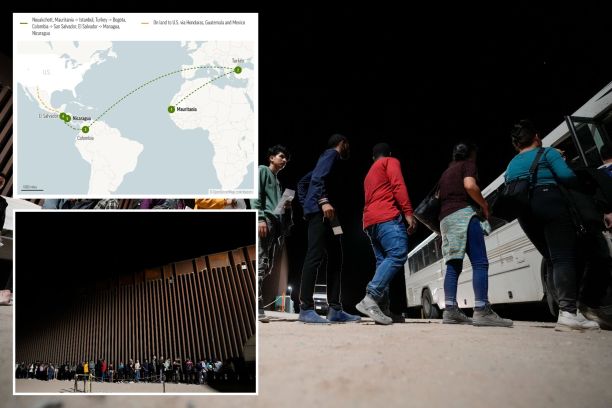Thousands of West African Migrants Entering US Through New Route Advertised Online; Thousands More Mauritanians are Making Their Way to the US, Thanks to a Route Spread on Social Media
Thousands of West African migrants entering US through new route advertised online:
Thousands of West African migrants are pouring into the US after social media helped spread the word about a lesser-known, low-stakes path through Nicaragua.
Mauritanians are using WhatsApp, Instagram and other channels to guide fellow migrants along the route, which makes stops in Turkey, Colombia, El Salvador and Managua, Nicaragua, where they are whisked onto a bus by smugglers to cross the US-Mexican border, according to the Associated Press.
Nicaragua, crucially, has relaxed entry requirements that allow Mauritanians and other foreign nationals to purchase a low-cost visa without proof of onward travel.
The influx was sudden and unexpected — and comes at a time when groups of 2,000 to 3,000 a week are being allowed to legally enter the US at El Paso, Texas.
Between March and June, more than 8,500 Mauritanians arrived by crossing the border illegally from Mexico, up from just 1,000 in the four months prior, according to US Customs and Border Protection data.
The new arrivals likely now outnumber the estimated 8,000 foreign-born Mauritanians already living in the US, about half of whom are in Ohio.
“Four months ago, it just went crazy,” said Oumar Ball, who arrived in Ohio from Mauritania in 1997 and recently opened his home to dozens of other new migrants that followed the new path. —>READ MORE HERE
Thousands more Mauritanians are making their way to the US, thanks to a route spread on social media
Aissata Sall was scrolling through WhatsApp in May when she first learned about the new route to the United States. For Ibrahima Sow, the discovery came on TikTok a few weeks later.
By the time their paths crossed at the tidy one-story brick house in Cincinnati, they had encountered hundreds of other Mauritanians, nearly all of them following a new path surging in popularity among younger migrants from the West African nation, thanks largely to social media.
“Four months ago, it just went crazy,” said Oumar Ball, who arrived in Cincinnati from Mauritania in 1997 and recently opened his home to Sow, Sall and more than a dozen other new migrants. “My phone hasn’t stopped ringing.”
The spike in migration was made possible by the discovery this year of a new route through Nicaragua, where relaxed entry requirements allow Mauritanians and a handful of other foreign nationals to purchase a low-cost visa without proof of onward travel.
As word of the entry point spreads, travel agencies and paid influencers have taken to TikTok to promote the trip, selling packages of flights that leave from Mauritania, then connect through Turkey, Colombia and El Salvador, and wind up in Managua, Nicaragua. From there, the migrants, along with asylum seekers from other nations, are whisked north by bus with the help of smugglers.
“The American dream is still available,” promises a video on TikTok, one of dozens of similar posts from French-speaking “guides” that help Mauritanians make the trip. “Don’t put off tomorrow what you can do today.”
“We wish you success. Nicaragua loves you very much,” a man working for a travel agency says in Spanish in another video.
The influx of Mauritanians has surprised officials in the U.S. It came without a triggering event – such as a natural disaster, coup or sudden economic collapse – suggesting the growing power of social media to reshape migration patterns: From March to June, more than 8,500 Mauritanians arrived in the country by crossing the border illegally from Mexico, up from just 1,000 in the four months prior, according to U.S. Customs and Border Protection data. —>READ MORE HERE







Comments are closed.